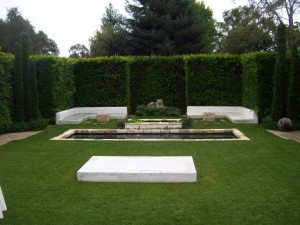Landscaping for privacy is common when living in an urban space. Although Santa Barbara might not be specifically classified as an urban space by most standards, this city’s geographical orientation with the mountains on one side and the ocean on the other has caused builders to make use of the space as creatively as they possibly can.
Many Santa Barbara living spaces are situated on stilts, terraced, and just plain built with the neighbors on the other side of the wall.
Living in close proximity can create privacy issues that are frequently solved with the strategic planting of hedges and tress. Proper landscaping can mute sound, provide some privacy from outside onlookers, and delineate property lines.
Landscaping for Privacy with Hedges and Trees
When it comes to creating privacy, you should use plant material, rather than fences and walls, as a first option. We like to call hedges living walls, because they provide much of the same buffer as hardscape walls in regards to sound, light, and screening, while also offering a softer living landscape of greenery and flowers. Hedges contribute to the ecology. They create oxygen and they balance the landscape.
Let’s explore our best tips on utilizing plant material for privacy.
Choosing the Best Plants for a Hedge and Privacy
There are three particular types of hedges that we love to use in Santa Barbara landscapes:
1. Privet (genus Ligustrum)
Ligustrum is an evergreen shrub that is native to the continents of Europe, North Africa, and Asia. We prefer to use the Ligustrum texanum, or the Texas Privet as our first choice for “living walls.”
We like it because it is particularly repellent to insects and disease. It is a hearty hedge, and provides thick growth that gives excellent screening against street noise. Once established, it requires little maintenance outside of regular pruning for height.
The only drawback to planting the privet is that its berries are not edible. Though they can be mildly unpleasant to humans, they can be harmful to domesticated animals.
If you have pets that like to eat foliage, or if you live on a ranch with horses, we suggest that you consider planting a different kind of hedge. However, the way we use privet for privacy requires regular maintenance. Regular pruning keeps berries from forming.
2. Eugenia (genus Myrtaceae)
Eugenia hedges are a flowering plant in the myrtle family. This hedge is native to all continents worldwide, though it is most often found in tropical or subtropical regions.
Like the privet, eugenias are fast growing and hearty. They also provide a striking green screen against sound and traffic.
They have beautiful flowers and berries that grow out of the flowers. Their berries are edible, and have traditionally been used in jams and jellies. I used to love to snack on them when I was a child.
The one drawback to planting eugenia is that they are particularly sensitive to attack from psyllid insects—a small plant-feeding/sucking insect. These insects suck the fluid out of the leaf and causes the leaves of the plants to develop bumps like look a bit human chicken pocks.
Take heart, though! If properly pruned and treated, this condition is both treatable and avoidable.
3. Pittosporum (genus Pittosporaceae)
This hedge is native to the same subtropical regions as the Eugenia.
They grow fast, live a long time, and are tolerable to all soils. They have beautiful, yellow flowers that bloom early in the spring. In Santa Barbara, these flowers are often considered the first heralds of spring.
There are a couple of minor drawbacks to consider when using the pittosporum. First, flowers are extremely potent. This is both a positive and a negative. The flowers smell delicious. They smell like a cross between citrus and jasmine. However, if you have allergies, that is a major downfall. Their sweet smell is filled with pollen.
Secondly, their sap, when cut, is incredibly tacky. If you get pittosporum sap on your skin, you may have to go as far as using nail polish remover to remove it.
Using Citrus Trees for Creating Backyard Privacy
Fruit trees are also a great option for training as living walls. We generally choose citrus because they are evergreen. All kinds of citrus trees can easily fill into to create a hedge.
They require little water, have delightfully scented flowers, and they love Santa Barbara’s climate. As a bonus, you get the fruit. Why not consider planting citrus as a barrier for peering eyes?
Of course, there are other choices for you to consider when you are looking to landscape for privacy in Santa Barbara. But we strongly recommended you put in plant material because it’s less expensive and it does better for the planet!
Call us at 805-765-2553 pr click here a FREE 42 Point Landscape Evaluation or quote.
Next blog: Part 2: Landscaping for Privacy – Walls and Fences






